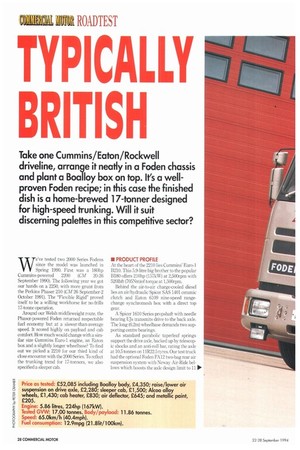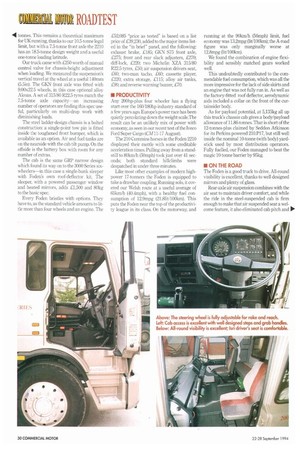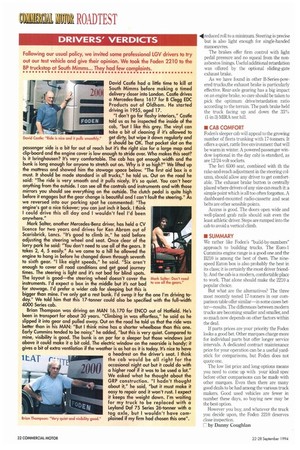TYPICALLY BRITISH
Page 30

Page 32

Page 34

If you've noticed an error in this article please click here to report it so we can fix it.
Take one Cummins/Eaton/Rockwell driveline, arrange it neatly in a Foden chassis and plant a Boalloy box on top. It's a wellproven Foden recipe; in this case the finished dish is a home-brewed 1 7-tonner designed for high-speed trunking. Will it suit discerning palettes in this competitive sector?
We've tested two 2000 Series Fodens since the model was launched in Spring 1990. First was a 180hp Cummins-powered 2200 (CM 20-26 September 1990). The following year we got our hands on a 2250, with more grunt from the Perkins Phaser 210 (CM 26 September-2 October 1991). The "Flexible Rigid" proved itself to be a willing workhorse for no-frills 17-tonne operation.
Around our Welsh middleweight route, the Phaser-powered Foden returned respectable fuel economy but at a slower-than-average speed. It scored highly on payload and cab comfort. How much would change with a similar size Cummins Euro-1 engine, an Eaton box and a slightly longer wheelbase? To find out we picked a 2210 for our third kind of close encounter with the 2000 Series. To reflect the trunking trend for 17-tormers, we also specified a sleeper cab. • PRODUCT PROFILE At the heart of the 2210 lies Cummins' Euro-1 B210. This 5.9-litre big brother to the popular B180 offers 210hp (157kW) at 2,500rpm with 5201bft (705Nm)of torque at 1,500rpm.
Behind the air-to-air charge-cooled diesel lies an air/hydraulic Spicer SAS 1401 ceramic clutch and Eaton 6109 nine-speed rangechange synchromesh box with a direct top gear.
A Spicer 1610 Series propshaft with needle bearing UJs transmits drive to the back axle. The long (6.2m) wheelbase demands two supporting centre bearings As standard parabolic taperleaf springs support the drive axle, backed up by telescopic shocks and an anti-roll bar, rating the axle at 10.5 tonnes on 11R22.5 tyres. Our test truck had the optional Foden FA12 two-bag rear air suspension system with Neway Air-Ride bellows which boosts the axle design limit to 11 tonnes. This remains a theoretical maximum for UK running, thanks to our 10.5-tonne legal limit, but with a 7.5-tonne front axle the 2210 has an 18.5-tonne design weight and a useful one-tonne loading latitude.
Our truck came with £250 worth of manual control valve for chassis-height adjustment when loading. We measured the suspension's vertical travel at the wheel at a useful 140mm (5.5in), The GKN front axle was fitted with 9.00x22.5 wheels, in this case optional alloy Alcoas. A set of 315/80 R22.5 t-,.,res match the 7.5-tonne axle capacity—an increasing number of operators are finding this spec useful, particularly on multi-drop work with diminishing loads.
The steel ladder-design chassis is a bolted construction: a single-point tow pin is fitted inside the toughened front bumper, which is available as an option. Air and fuel tanks are on the nearside with the cab tilt pump. On the offside is the battery box with room for any number of extras.
The cab is the same GRP narrow design which found its way on to the 3000 Series sixwheelers—in this case a single-bunk sleeper with Foderis own roof-deflector kit. The sleeper, with a powered passenger window and heated mirrors, adds £1,500 and 80kg to the basic spec.
Every Foden bristles with options. They have to, as the standard vehicle amounts to little more than four wheels and an engine. The £52,085 "price as tested" is based on a list price of £39230, added to the major items listed in the "in brief" panel, and the following exhaust brake, £185: GEN 575 front axle, £275; front and rear slack adjusters, £270; diff-lock, £220; two Michelin XZA 315/80 R22.5 tyres, £50; air suspension drivers seat, £ 60; two-man tacho, £60; cassette player; £220; extra storage, £115; alloy air tanks, £90; and reverse warning buzzer, £70.
• PRODUCTIVITY Any 200hp-plus four wheeler has a flying start over the 160/180hp industry standard of a few years ago. Europe's power race has been quietly percolating down the weight scale.The result can be an unlikely mix of power with economy, as seen in our recent test of the Neco Ford Super Cargo (CM11.17 August).
The 210 Cummins horses in the Foden 2210 displayed their mettle with some creditable acceleration times. Pulling away from a standstill to 80km/b (50mph) took just over 41 seconds; both standard hillclimbs were despatched in under three minutes.
Like most other examples of modern highpower 17-tonners the Foden is equipped to take a drawbar coupling. Running solo, it covered our Welsh route at a useful average of 65kin/h (40.4mph), with a healthy fuel consumption of 12.9mpg (21.81it/100km). This puts the Foden near the top of the productivity league in its class. On the motorway, and running at the 90km/h (56mph) limit, fuel economy was 13.2mpg (lit/100km); the A-road figure was only marginally worse at 12.8mpg (lit/100km).
We found the combination of engine flexibility and sensibly matched gears worked well.
This undoubtedly contributed to the commendable fuel consumption, which was all the more impressive for the lack of side skirts and an engine that was not fully run in. As well as the factory-fitted roof deflector, aerodynamic aids included a collar on the front of the curtainsider body.
As for payload potential, at 5,135kg all up this truck's chassis cab gives a body/payload allowance of 11.86-tonnes. That is short of the 12-tonnes-plus claimed by Seddon Atkinson for its Perkins powered 210.P17, but still well inside the nominal 10-tonne (with body) yardstick used by most distribution operators. Fully fuelled, our Foden managed to beat the magic 10-tonne barrier by 95kg.
• ON THE ROAD The Foden is a good truck to drive. All-round visibility is excellent, thanks to well designed mirrors and plenty of glass.
Rear-axle air suspension combines with the air seat to maintain driver comfort, and while the ride in the steel-suspended cab is firm enough to make that air suspended seat a welcome feature, it also eliminated cab pitch and
411 reduced roll to a minimum. Steering is precise but is also light enough for single-handed manoeuvres.
The brakes offer firm control with light pedal pressure and no squeal from the nonasbestos linings. Useful additional retardation was offered by the optional sliding-gate exhaust brake.
As we have found in other B-Series-powered trucks,the exhaust brake is particularly effective. Rear-axle gearing has a big impact on an engine brake, so care should be taken to pick the optimum drive/retardation ratio according to the terrain. The park brake held the truck facing up and down the 33% (1-in-3)1VIIRA test hill.
II CAB COMFORT Foden's sleeper cab will appeal to the growing number of fleets trunking with 17-tonners. It offers a quiet, rattle free environment that will be warm in winter. A powered passenger window (optional in the day cab) is standard, as are 12/24-volt sockets.
The Isri 6500 seat, combined with th the rake-and-reach adjustment in the steering column, should allow any driver to get comfortable. The exhaust brake button is centrally placed where drivers of any size can reach it: a simple point which is all too often forgotten. A dashboard-mounted radio-cassette and seat belts are other sensible points.
Access is good. The doors open wide and well-placed grab rails should suit even the least athletic driver. Steps are ramped into the cab to avoid a vertical climb.
• SUMMARY We rather like Foden's "build-by-numbers" approach to building trucks. The Euro-1 Cummins engine range is a good one and the B210 is among the best of them. The ninespeed Eaton box is also probably the best in its class; it is certainly the most driver friendly. And the cab is a modern, comfortable place to work. That alone should make the 2210 a popular choice.
But what are the alternatives? The three most recently tested 17-tormers in our comparison table offer similar—in some cases better—results. The differences between modern trucks are becoming smaller and smaller, and so much now depends on other factors within the deal.
If parts prices are your priority the Foden looks a good bet. Other marques charge more for individual parts but offer longer service intervals. A dedicated contract maintenance price for your operation can be a useful yardstick for comparisons, but Foden does not quote one.
The low list price and long options means you need to come up with your ideal spec before other comparisons can be made with other marques. Even then there are many good deals to be had among the various truck makers. Good used vehicles are fewer in number these days, so buying new may be the best option.
However you buy, and whatever the truck you decide upon, the Foden 2210 deserves close inspection.
I— by Danny Coughlan
























































































